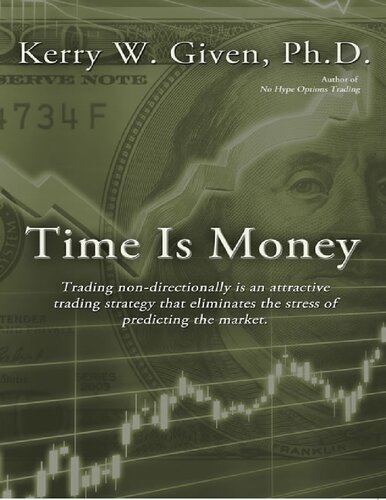دانلود کتاب Time is Money: The Power of Non-Directional Options Trading - Original PDF
Author:
Kerry W. Given
0 (0)
توضیحات کتاب :
The new book, Time Is Money, comes from Kerry Given, the author of No Hype Options Trading, and he discusses the concept of non-directional trading. If you have some experience with options trading, you have probably heard the term, delta neutral trading. This is one of the buzzword phrases that has been used in marketing options trading education, trading alert services, and describing the strategies of hedge funds. Delta neutral does sound exotic - is this the trading secret I have been searching for? But we will see clearly in this book that there is no "secret" to options trading. Non-directional trading is a lesser known term and may be considered a subset of delta neutral trading. This book does an excellent job of distinguishing delta neutral trading from non-directional trading. These are not synonyms. The trader may use a delta neutral strategy because he is predicting a sideways price pattern or price movement within a modest sized channel. The delta neutral trade is just one choice among several options strategies. If the trader is bullish, he selects a bullish trade; if he is bearish, he selects a bearish trade. And if his prediction is for a sideways price movement, he selects a delta neutral trade. This trader is using a delta neutral trading strategy as a directional trade; it is based on the trader's prediction for the future price movement of the underlying stock or market index. The directional trader has a specific interest with particular knowledge about an individual stock or index and a prediction for its future value. Dr. Given distinguishes non-directional trading from delta neutral trading in one critically important way. If one is trading non-directionally, he develops a series of rules for entry, exit and adjustment of a delta neutral trading strategy and then enters and manages the position dictated by those rules month after month. He has made no prediction of the future; he just manages the position each day based on the market's price move that day. The trader is no longer predicting the market's next move tomorrow; the trader is reacting to what the market gives him today. The non-directional trader tries his best not to predict where the market is going tomorrow. Instead, he focuses on where the market is today and the actions his rules dictate. He follows the rules. This may seem like a fine distinction in semantics, but give Time Is Money a try. Focus on what the market is doing today and what your rules dictate. Throw away your crystal ball. About the Author - Kerry W. Given, Ph.D., is the founder of Parkwood Capital, LLC, a business that consists of stock and options coaching, a weekly newsletter, and two trading advisory services. Dr. Given is a co-founder of G&L Capital Management, LLC and manages the Theta Income Fund. Kerry speaks frequently at trading conferences and on behalf of several option brokerage firms. Kerry is the author of No Hype Options Trading, published by John Wiley and Sons. Dr. Given earned his B.S. from the University of Florida and his Ph.D. from the University of Minnesota.
سرچ در وردکت | سرچ در گودریدز | سرچ در اب بوکز | سرچ در آمازون | سرچ در گوگل بوک
1,229 بازدید 0 خرید










